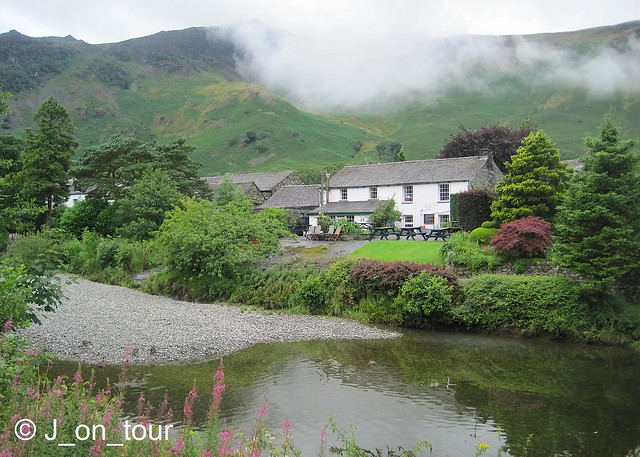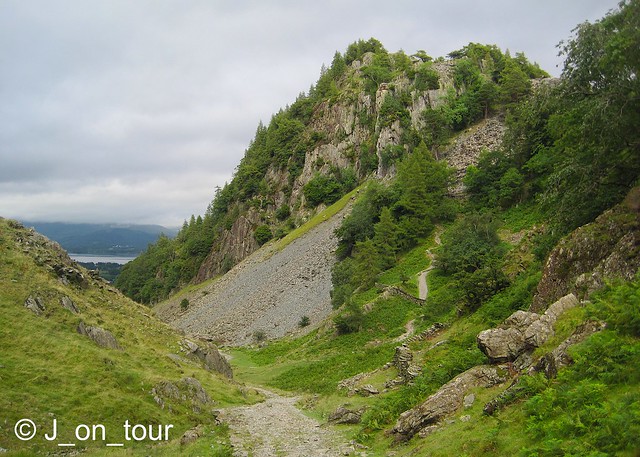Blea Rigg is a mixture of crag and summit on a linear style upland plateau stretching from Grasmere to the Langdale Pikes. The above view is the most appropriate photograph of the fell taken from Easedale tarn. The final stages of the ascent was up the left hand side to the summit in the centre.
This was a difficult day to judge for a number of reasons. There was heavy rain during the morning and it was difficult to see anything of the hills at all, far less photograph them. As a tourist, I do not mind using a certain car park in Grasmere, but as a walker, I use a different place on the main road which tends to fill up early. As I arrived in early afternoon, there were no spaces left and I had to park a reasonable distance away from the start of the walk outside someones house on the main road further up towards Dunmail raise. Although I didn't mind the extension to the walk, the clouds did nothing for the results in the photographs and in a sense, I considered leaving this post out as this was the only one that I have had to motivate myself with so far. The walkers amongst you will be happy enough with the pictures but I have had to add a bit more text for the photographers and tourists amongst you as I realise that the pictures may not stimulate everyone.
 |
| Sour Milk Gill waterfall and Brimmer Head farm |
The start of this walk is usually from Easedale road beside the Heaton Cooper Art studio, although I joined the official route a little way further on. Once leaving the road, I was greeted with the above view with the path going up the left hand side of the waterfall before disappearing around the lower crag to the left. William Wordsworth could apparently see this valley from Dove Cottage in Grasmere and named the view "the black quarter" due to the positioning of the sun and the resulting shadows....... very apt indeed I think, due to the lack of it today !!
Once around the corner and after a short walk, Easedale tarn is reached. This is the largest mountain lake in the Lake district at 480m x 300m and is enclosed in a three sided combe bordered by Tarn Crag to the north, Belles Knott to the west and this view from the slopes of Blea Rigg. Incidently, the view below was taken from the opposite direction as the first photograph in this set.

The last time I passed Easedale tarn, it was glorious sunshine and with the amount of people I saw by its shores as a final destination, there should have been an Ice cream van nearby!! You may find that comment rather amusing as you consider the steepness of the path adjacent to the waterfall, but there was a time in the past when a local entrepreneur had an eye for business. There was a small stone refreshment hut beside these shores that drinks were served from. One of the things that had to be maintained was the path past the waterfall in order that he may attract regular customers and it is said that he carried a boat up for hire on the Lake too !! The business eventually closed and souvenir hunters collected pieces of the property over a period of time before a team of volunteers were assigned to dismantle the unsafe structure.

On reaching the summit, the eye is drawn to the south where Windermere, the largest lake, is seen. Langdale valley commences in the foreground heading to the right with Elterwater also viewed in this shot.
The tension of sunshine and cloud is shown above at the summit area with The higher Bowfell in the distance on the left being in cloud rather than the lower and more famous Langdale Pikes on the right.
The photo below depicts the three longitudinal hill ranges coming from the Central Fells area all pointing towards and ending at different stages in the direction of Grasmere......
...... Front to back : Tarn Crag, Calf Crag to Helm Crag range, Steel Fell and Helvellyn in cloud in the rear. After following an interesting path around small tarns and rocky outcrops along the undulating top in the Grasmere direction, it was time to descend down into Easedale valley. My destination was the large white building just to the left of centre.....
I felt that this album was more of a walking journal that lacked a bit of colour, so I managed to capture something that might seem out of place on the way down...
There were more conventional opportunities for Lake district scenes on the valley floor....
.... and a customary piece of humour from myself to finish with. This may seem like a blot on the picturesque landscape but farmers look after their sheep by storing grass for the winter.....
so DON"T JUMP !! ..
























































